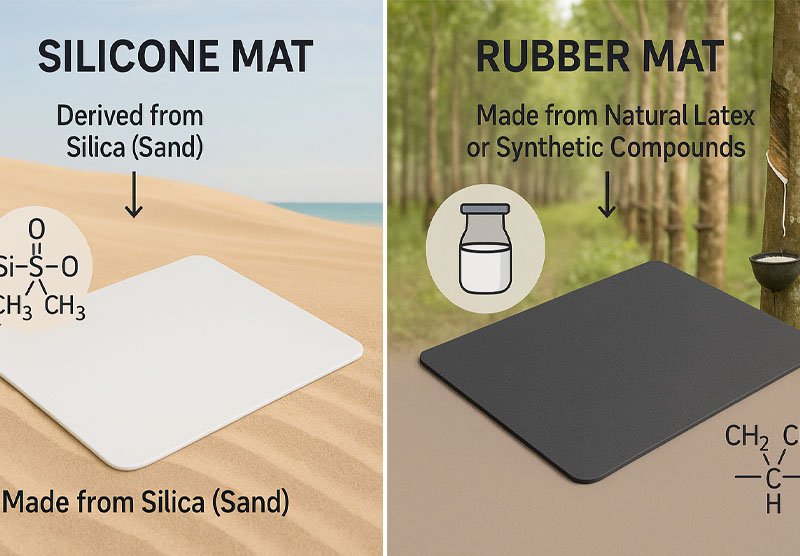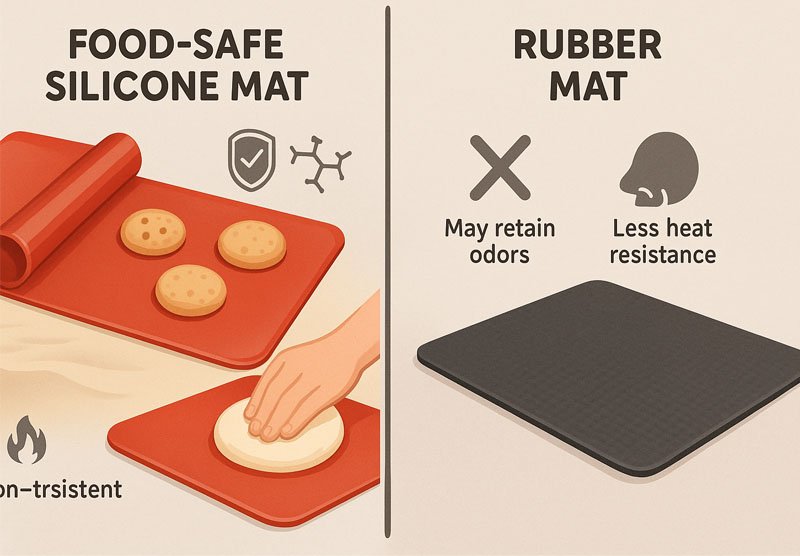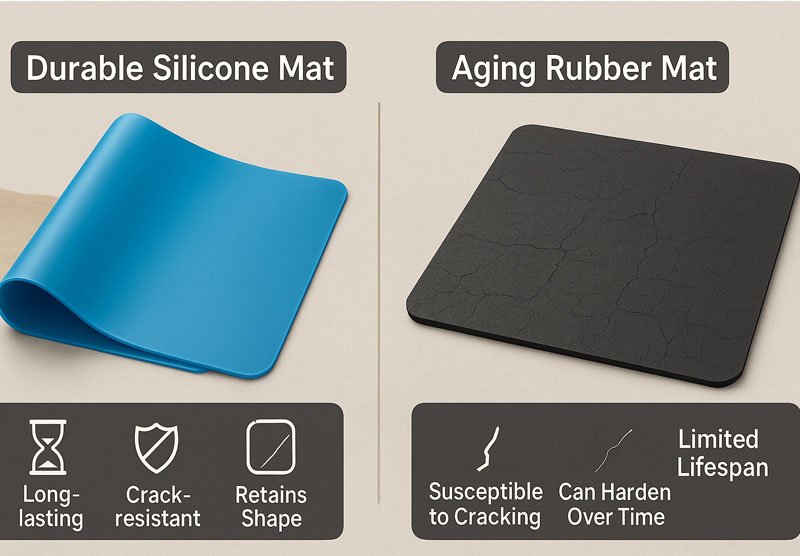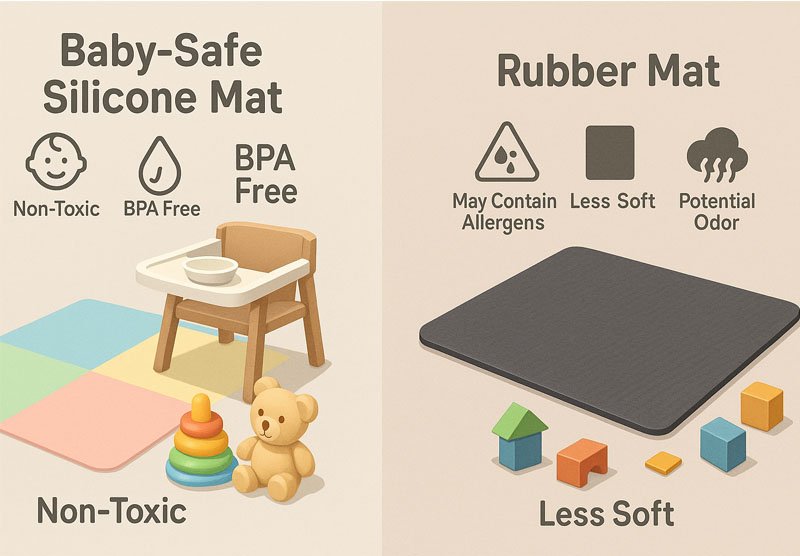Rubber and silicone mats look similar—but are they really interchangeable in food, baby, or industrial use?
Silicone mats offer better heat resistance, safety, and longevity than rubber mats, making them the preferred choice in food-grade and medical applications. Rubber mats are cheaper but limited.
I’ve worked with both materials across multiple industries—from baby product design to industrial kitchenware. While both have their place, the right choice depends on how and where the mat will be used. Let’s explore the differences in depth.
What Are Silicone and Rubber Mats Made Of?
Before comparing, it’s important to understand the materials themselves.
Silicone mats are made from synthetic polymers derived from silica (sand), while rubber mats are made from either natural rubber (latex) or synthetic rubber compounds.

Silicone is a highly flexible, stable material formed by combining silicon, oxygen, carbon, and hydrogen. Rubber, by contrast, may be:
- Natural Rubber (NR): From rubber trees
- Synthetic Rubber (like EPDM, SBR, or NBR): From petroleum-based polymers
Here’s a basic material comparison:
| Property | Silicone | Rubber |
|---|---|---|
| Base Material | Silica-based | Plant or petroleum-based |
| Heat Resistance | Excellent (up to 230°C) | Moderate (80–120°C typical) |
| UV Resistance | Very High | Moderate |
| Odor/Taste Neutrality | High | Low (often smells rubbery) |
| Toxicity Risk | Non-toxic | Can leach chemicals |
| Eco-Profile | Durable, recyclable | Can degrade, harder to recycle |
Silicone is more chemically stable. That makes it ideal for food contact, medical-grade tools, or anything that requires frequent sterilization.
How Do Silicone and Rubber Mats Perform in Food Applications?
Food safety is a top priority. Which material is safer for kitchen use?
Silicone is food-safe, odorless, and compliant with FDA and LFGB standards. Rubber mats often fail safety and migration tests for food contact.

I’ve had multiple clients ask why their rubber mats were rejected by inspectors. The answer is often simple: rubber can leach chemicals. Natural rubber might be safe in theory, but it’s hard to stabilize without additives. Many commercial rubber mats use sulfur, fillers, or dyes that aren’t food-safe.
Silicone, on the other hand:
- Passes food-grade tests globally
- Does not retain odors or flavors
- Withstands dishwashing and high-temperature cleaning
- Does not degrade over time
That’s why I always recommend silicone mats for baking, baby feeding, and high-heat kitchen prep. Rubber mats may work in low-risk areas like anti-slip surfaces, but not where food or skin contact occurs.
Which One Lasts Longer in Daily Use?
Durability matters, especially in high-traffic or commercial environments.
Silicone mats maintain their shape and safety properties longer than rubber, which tends to crack, warp, or degrade over time.

Rubber may be cheaper at first, but it degrades faster. It becomes brittle with heat, light, or oil exposure. Silicone resists all of these stressors. That makes a big difference in:
- Oven use (rubber mats can’t handle it)
- Outdoor UV exposure
- Chemical cleaning agents
- Repeated flexing or rolling
Here’s a long-term usage comparison:
| Feature | Silicone Mat | Rubber Mat |
|---|---|---|
| Avg. Lifespan (Commercial) | 2–5 Years | 6–12 Months |
| Oven/Microwave Compatibility | Yes | No |
| Dishwasher Safe | Yes | Not recommended |
| Flexibility Over Time | Stays flexible | Becomes brittle |
| Smell/Odor After Use | Neutral | Often rubbery smell |
In one of our commercial bakery projects, switching from rubber-lined trays to silicone mats reduced replacement costs by over 60% annually.
Which Material Is Better for Medical or Baby Products?
Safety is non-negotiable when it comes to infants or healthcare.
Silicone is the clear winner for baby and medical applications due to its hypoallergenic, non-toxic, and sterilizable properties.

Rubber can cause allergic reactions—especially natural latex rubber. This is a dealbreaker for medical-grade or infant products. Silicone, particularly platinum-cured silicone, is:
- Biocompatible
- Sterilizable at high heat
- Hypoallergenic
- Odorless and tasteless
This is why all teething rings, pacifier mats, and even surgical tubing are made from silicone. In fact, several of our baby product clients have requested only LFGB- and FDA-certified platinum silicone since 2022.
Medical facilities use silicone mats in sterilization trays, surgical tools, and lab settings where precision and chemical resistance are critical.
Is There a Price Difference Between Silicone and Rubber?
Cost matters—but so does total value over time.
Rubber mats are cheaper upfront, but silicone mats offer greater long-term value through durability, safety, and performance.
Let’s compare real-world numbers from a medium-sized bakery:
| Cost Element | Rubber Mat | Silicone Mat |
|---|---|---|
| Upfront Cost per Mat | $3.50 | $7.50 |
| Avg. Lifespan | 6 Months | 2+ Years |
| Replacement Cost (2 Years) | $14.00 | $7.50 |
| Total Cost Over 2 Years | High | Low |
Even though rubber mats seem affordable, frequent replacements and hygiene issues make them more expensive in the long run. For clients like John Doe from Little Steps Baby Care, safety and reusability mattered more than the upfront savings.
Which One Should You Choose?
Still unsure which one fits your business?
Choose silicone if you need safety, durability, and heat resistance. Choose rubber only for basic anti-slip, non-food, low-temperature use.
Here’s a quick guide:
| Use Case | Recommended Material |
|---|---|
| Baby Products (feeding, play) | Silicone |
| Food Prep & Baking | Silicone |
| Medical Applications | Silicone |
| Industrial Anti-Slip Flooring | Rubber |
| Gym/Exercise Mats | Rubber (non-contact) |
| Outdoor Tool Grips or Padding | Rubber (UV-protected) |
| Chemical Labs | Silicone |
I always tell my clients: rubber mats work until you need them to work well. That’s when silicone proves its value.
Conclusion
Silicone mats outperform rubber in safety, durability, and versatility—especially for food, medical, and baby applications.